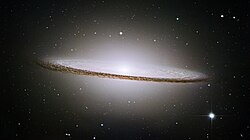Fayl:Sombrero Galaxy in infrared light (Hubble Space Telescope and Spitzer Space Telescope).jpg

Sınaq göstərişi ölçüsü: 800 × 448 piksel. Digər ölçülər: 320 × 179 piksel | 640 × 359 piksel | 1.024 × 574 piksel | 1.280 × 717 piksel | 3.000 × 1.681 piksel.
Faylın orijinalı (3.000 × 1.681 piksel, fayl həcmi: 3,98 MB, MIME növü: image/jpeg)
Faylın tarixçəsi
Faylın əvvəlki versiyasını görmək üçün gün/tarix bölməsindəki tarixlərə klikləyin.
| Tarix/Vaxt | Kiçik şəkil | Ölçülər | İstifadəçi | Şərh | |
|---|---|---|---|---|---|
| indiki | 20:46, 20 iyul 2009 |  | 3.000 × 1.681 (3,98 MB) | Tryphon | {{Information |Description=NASA/ESA Hubble Space Telescope and NASA's Spitzer Space Telescope joined forces to create this striking composite image of one of the most popular sights in the universe. Messier 104 is commonly known as the Sombrero galaxy bec |
Fayl keçidləri
Aşağıdakı səhifə bu faylı istifadə edir:
Faylın qlobal istifadəsi
Bu fayl aşağıdakı vikilərdə istifadə olunur:
- ast.wikipedia.org layihəsində istifadəsi
- bs.wikipedia.org layihəsində istifadəsi
- cs.wikipedia.org layihəsində istifadəsi
- de.wikipedia.org layihəsində istifadəsi
- en.wikipedia.org layihəsində istifadəsi
- en.wikiquote.org layihəsində istifadəsi
- en.wikiversity.org layihəsində istifadəsi
- es.wikipedia.org layihəsində istifadəsi
- fa.wikipedia.org layihəsində istifadəsi
- frp.wikipedia.org layihəsində istifadəsi
- fr.wikipedia.org layihəsində istifadəsi
- he.wikipedia.org layihəsində istifadəsi
- id.wikipedia.org layihəsində istifadəsi
- it.wikibooks.org layihəsində istifadəsi
- kk.wikipedia.org layihəsində istifadəsi
- kn.wikipedia.org layihəsində istifadəsi
- mg.wikipedia.org layihəsində istifadəsi
- pl.wikipedia.org layihəsində istifadəsi
- pt.wikipedia.org layihəsində istifadəsi
- simple.wikipedia.org layihəsində istifadəsi
- sk.wikipedia.org layihəsində istifadəsi
Bu faylın qlobal istifadəsinə baxın.



